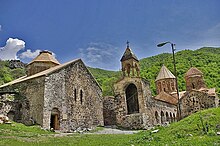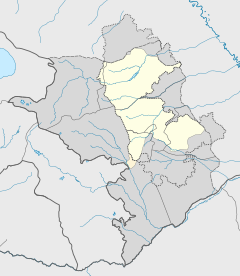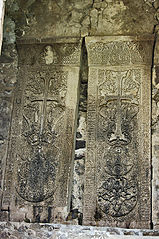| Revision as of 20:29, 12 November 2020 view source2600:1700:2cc1:2b30:2850:6517:2aec:a378 (talk)No edit summaryTag: Reverted← Previous edit | Revision as of 21:14, 12 November 2020 view source Ed88 (talk | contribs)Extended confirmed users1,577 edits →Restoration: linksTag: RevertedNext edit → | ||
| Line 43: | Line 43: | ||
| == Restoration == | == Restoration == | ||
| In 1994, following the end of the Nagorno-Karabakh war, the monastery was reopened, and in 2004, a renovation process began with funding from ] businesswoman Edele Hovnanian, ending in 2005. The restoration efforts restored the cathedral, along with a chapel which was restored by Edik Abrahamian, an Armenian from ].<ref>http://www.raa.am/Magazine/Activity/FR_set_E_Activity.htm Restoration in Dadivank</ref> | In 1994, following the end of the ], the monastery was reopened, and in 2004, a renovation process began with funding from ] businesswoman Edele Hovnanian, ending in 2005. The restoration efforts restored the cathedral, along with a chapel which was restored by Edik Abrahamian, an Armenian from ].<ref>{{Cite web |url=http://www.raa.am/Magazine/Activity/FR_set_E_Activity.htm |title=Restoration in Dadivank |date=2005 |access-date=12 November 2020 |work=Research on Armenian Architecture}}</ref> | ||
| In August 2017, Italian specialists who had previously conducted restoration operations at Davidank returned to continue their cleaning and restoration of the monastery. They had already restored of the four chapels and their frescoes, and were now planning to restore inscriptions and ornaments near the doors to the chapels. The entire restoration project is planned to be completed by 2020.<ref>https://news.am/eng/news/403138.html Italian specialists to arrive in Karabakh to continue Dadivank Monastery restoration</ref> | In August 2017, Italian specialists who had previously conducted restoration operations at Davidank returned to continue their cleaning and restoration of the monastery. They had already restored of the four chapels and their frescoes, and were now planning to restore inscriptions and ornaments near the doors to the chapels. The entire restoration project is planned to be completed by 2020.<ref>{{Cite web |url=https://news.am/eng/news/403138.html |title=Italian specialists to arrive in Karabakh to continue Dadivank Monastery restoration |date=2 August 2017 |access-date=12 November 2020 |work=News.am}}</ref> | ||
| However, as a result of ] which resulted in a cease-fire agreement stipulating an Armenian withdrawal from Dadivank and a hand-over of the surrounding area to ], the Abbot of the Dadivank Monastery decided to bring the monastery's Christian art of significance to Armenia, due to fears of destruction by the Azeris.<ref>https://news.am/eng/news/612601.html</ref> | However, as a result of ] which resulted in a ] stipulating an Armenian withdrawal from Dadivank and a hand-over of the surrounding area to ], the Abbot of the Dadivank Monastery decided to bring the monastery's Christian art of significance, including bells and ]s, to Armenia, due to fears of destruction by the Azeris.<ref>{{Cite web |url=https://news.am/eng/news/612601.html |title=Father Hovhannes of Artsakh's Dadivank Monastery to bring bells and cross to Armenia |date=10 November 2020 |access-date=12 November 2020 |work=News.am}}</ref> | ||
| ==Gallery== | ==Gallery== | ||
Revision as of 21:14, 12 November 2020
| Dadivank Դադիվանք | |
|---|---|
 The monastery of Dadivank The monastery of Dadivank | |
| Religion | |
| Affiliation | Armenian Apostolic Church |
| Location | |
| Location | Shahumyan Province, Nagorno-Karabakh Republic (de facto); Azerbaijan (de jure) |
 | |
| Geographic coordinates | 40°09′42″N 46°17′18″E / 40.1616°N 46.2882°E / 40.1616; 46.2882 |
| Architecture | |
| Type | Monastery, Church |
| Style | Armenian |
| Completed | 9th–13th centuries |
Dadivank (Template:Lang-hy), also Khutavank (Template:Lang-hy), is an Armenian monastery, de facto controlled by the Republic of Artsakh as part of its Shahumyan Province, de jure in the Kalbajar District of Azerbaijan. It was built between the 9th and 13th centuries.
History and architecture
The monastery was founded by St. Dadi, a disciple of Thaddeus the Apostle who spread Christianity in Western Armenia during the first century AD. However, The monastery was first mentioned in the 9th century. In July, 2007, the grave of St. Dadi was discovered under the holy altar of the main church. The princes of Upper Khachen are also buried at Dadivank, under the church's gavit.
Restoration
In 1994, following the end of the Nagorno-Karabakh war, the monastery was reopened, and in 2004, a renovation process began with funding from Armenian-American businesswoman Edele Hovnanian, ending in 2005. The restoration efforts restored the cathedral, along with a chapel which was restored by Edik Abrahamian, an Armenian from Tehran, Iran.
In August 2017, Italian specialists who had previously conducted restoration operations at Davidank returned to continue their cleaning and restoration of the monastery. They had already restored of the four chapels and their frescoes, and were now planning to restore inscriptions and ornaments near the doors to the chapels. The entire restoration project is planned to be completed by 2020.
However, as a result of Nagorno-Karabakh war in 2020 which resulted in a cease-fire agreement stipulating an Armenian withdrawal from Dadivank and a hand-over of the surrounding area to Azerbaijan, the Abbot of the Dadivank Monastery decided to bring the monastery's Christian art of significance, including bells and khachkars, to Armenia, due to fears of destruction by the Azeris.
Gallery
-
 Dadivank
Dadivank
-
 General view
General view
-
 Side view
Side view
-
 Khachkars at Dadivank
Khachkars at Dadivank
Books
- (in French) Le Petit Futé Arménie – by Dominique Auzias, Jean-Paul Labourdette – 2009 – 330 pages
- Armenologie in Deutschland, by Armenuhi Drost-Abgarjan, Hermann Goltz – 2005 – p. 59
- (in Italian) Documenti di architettura armena, Alexandr L. Jakobson – 1986 – 73 p.
References
- Жеан-Паул Лабурдетьте, Доминикуе Аузиас, Армения, Petit Futé, 2007 – p. 203
- Robert G. Ousterhout. A Byzantine settlement in Cappadocia. — Dumbarton Oaks, 2006. — p. 151."In the Armenian monastery of Dadivank', however, dated 1211, a four-columned, domed hall is set into a range of rooms chat included the kitchen and refectory."
- "Dadivank", one of the best known Armenian monasteries in Arts'akh (Nagorno - Karabakh)" // Journal of the Society for Armenian Studies (California State University), 1995, vol.6-7, p. 51
- В старинном монастыре Нагорного Карабаха обнаружены мощи одного из учеников Иисуса Христа
- Georgia, by John Noble, Michael Kohn, Danielle Systermans, Lonely Planet, 2008 – 364 pages, p. 307
- "Restoration in Dadivank". Research on Armenian Architecture. 2005. Retrieved 12 November 2020.
- "Italian specialists to arrive in Karabakh to continue Dadivank Monastery restoration". News.am. 2 August 2017. Retrieved 12 November 2020.
- "Father Hovhannes of Artsakh's Dadivank Monastery to bring bells and cross to Armenia". News.am. 10 November 2020. Retrieved 12 November 2020.
External links
- Dadivank Monastery
- Dadivank Gallery
- Recent Historical-Architectural Research on Dadivank
- Gandzasar.com: Pilgrimage and Tourism, Nagorno Karabakh Republic
- Dadivank Monastery at wikimapia.org
- Program about Dadi Monastery by Vem Radio



